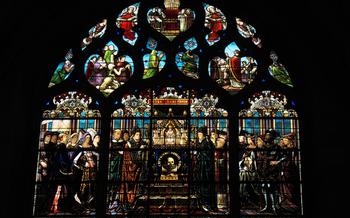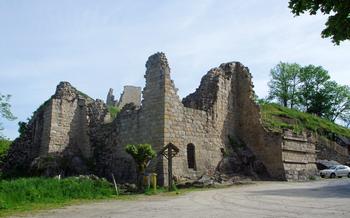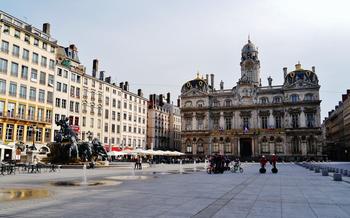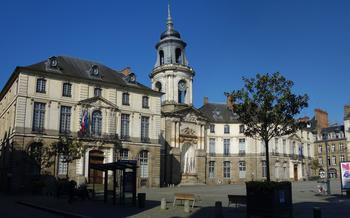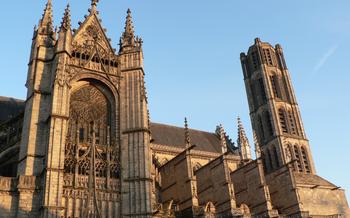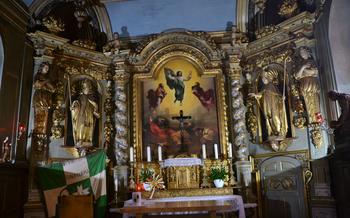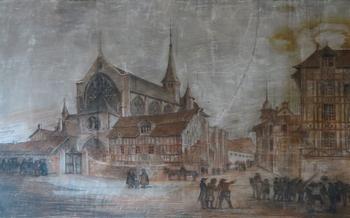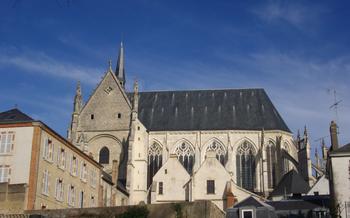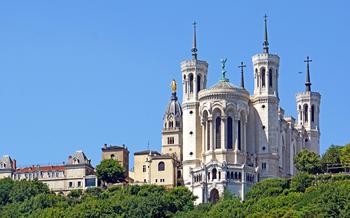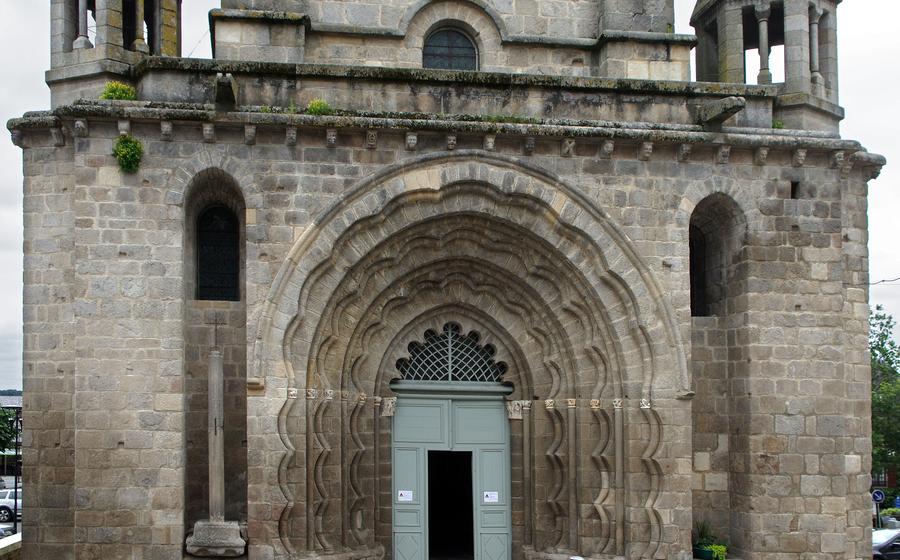
Crypte de Saint Martial
- Historical Significance
- Architectural Marvel
- Religious Relics
- Artistic Treasures
- Excavations and Discoveries
- Guided Tours
- Location and Accessibility
- Dress Code and Etiquette
- Photography and Videography
- Souvenirs and Merchandise
- Accessibility for Visitors with Disabilities
- Nearby Attractions
- Local Cuisine and Dining Options
- Insider Tip: Hidden Treasures Revealed
Historical Significance
The Crypte de Saint Martial stands as a testament to the rich history and religious significance of Limoges. Its origins can be traced back to the 10th and 11th centuries, when it was constructed as a resting place for Saint Martial, the first bishop of Limoges. Saint Martial played a pivotal role in spreading Christianity throughout the region, and his remains were believed to possess miraculous powers, attracting pilgrims from far and wide. The crypt became a major pilgrimage site, contributing to Limoges' status as a significant religious center during the Middle Ages.
Architectural Marvel
The Crypte de Saint Martial stands as a testament to the architectural prowess of the Romanesque era. Its barrel-vaulted ceiling, a hallmark of Romanesque architecture, creates a sense of awe and wonder. The intricate carvings and stone sculptures that adorn the crypt's interior showcase the skill and artistry of medieval craftsmen. These carvings depict biblical scenes, mythical creatures, and historical figures, each telling a story and contributing to the overall narrative of the crypt.
The Romanesque style, which emerged in the 10th century, marked a departure from the earlier Carolingian architecture. It emphasized the use of round arches, barrel vaults, and thick walls. The Crypte de Saint Martial exemplifies these characteristics, showcasing the transition from the heavy, squat forms of Carolingian architecture to the more refined and elegant style of the Romanesque period.
The remarkable preservation of the crypt is a testament to its enduring legacy. Despite centuries of use and the occasional ravages of time, the crypt has retained its original grandeur and charm. It stands as a living testament to the architectural prowess of the medieval era and serves as a valuable resource for studying the evolution of Romanesque architecture.
Religious Relics
Enriching the spiritual significance of the Crypte de Saint Martial is its role as a revered repository for religious relics. Among these sacred treasures, the remains of Saint Martial hold a position of profound importance. Venerated as the first bishop of Limoges, Saint Martial is believed to have played a pivotal role in spreading Christianity throughout the region. The faithful flock to the crypt, seeking solace and inspiration through the intercession of this revered saint.
Over the centuries, numerous miracles have been attributed to Saint Martial, further solidifying his status as a powerful spiritual figure. Pilgrims from far and wide journey to the crypt, drawn by the allure of these miraculous tales. They engage in rituals and ceremonies, seeking blessings, healing, and divine intervention. The crypt's sacred atmosphere, coupled with the presence of Saint Martial's relics, creates a palpable sense of spirituality that resonates with visitors of all faiths.
Artistic Treasures
The Crypte de Saint Martial is home to an impressive collection of medieval frescoes and paintings, a testament to the artistic heritage of Limoges. These artworks, created between the 11th and 13th centuries, depict biblical scenes, the lives of saints, and symbolic representations. The artists employed various techniques, including fresco, tempera, and oil, resulting in vibrant and expressive imagery.
The iconography of the frescoes draws upon both Byzantine and Romanesque influences, creating a unique artistic blend. The Byzantine influence is evident in the use of gold leaf backgrounds, elongated figures, and a focus on spirituality. The Romanesque style, on the other hand, is characterized by its emphasis on narrative, emotional expressiveness, and the depiction of everyday life.
One of the most notable frescoes is the "Descent into Hell," which portrays Christ's harrowing of hell and his triumph over death. The vivid colors, dynamic composition, and expressive figures convey the drama and power of this pivotal event. Another highlight is the "Life of Saint Martial," a series of paintings narrating the life and miracles of the saint. These artworks offer a glimpse into the medieval cult of Saint Martial and his importance in the region.
The frescoes and paintings in the Crypte de Saint Martial are not only aesthetically pleasing but also provide valuable insights into the religious beliefs, artistic traditions, and cultural influences that shaped medieval Limoges. They are a testament to the skill and devotion of the artists who created them, and they continue to captivate visitors centuries later.
Excavations and Discoveries
Archaeological excavations conducted at the Crypte de Saint Martial have unearthed a wealth of ancient artifacts and remnants of earlier structures, shedding light on the site's rich history. These excavations have revealed foundations of earlier churches dating back to the 5th and 6th centuries, providing evidence of the site's continuous religious significance. Additionally, archaeologists have discovered fragments of Roman pottery, coins, and jewelry, suggesting the area's occupation during Roman times. Ongoing research and conservation efforts aim to preserve and study these findings, deepening our understanding of the crypt and its surroundings.
Guided Tours
Enhance your visit to the Crypte de Saint Martial by taking advantage of the guided tours offered. Led by knowledgeable and passionate guides, these tours provide an immersive and informative experience.
Unveiling the Crypt's Secrets:
A guided tour of the Crypte de Saint Martial is an excellent way to gain a deeper understanding of its history, architecture, and religious significance. The guides, often experts in medieval history and art, share fascinating insights and anecdotes that bring the crypt's stories to life.
Immerse Yourself in History:
As you walk through the ancient chambers, your guide will explain the crypt's construction, its role as a pilgrimage site, and the significance of the relics it houses. You'll learn about the life of Saint Martial, the first bishop of Limoges, and his impact on the spread of Christianity in the region.
Discover Hidden Treasures:
With a guide, you'll uncover the crypt's hidden treasures, such as intricate carvings, stunning frescoes, and remarkable sculptures. The guides will point out details that you might miss on your own, enhancing your appreciation for the crypt's artistic and architectural marvels.
Tailor Your Experience:
Guided tours are available in various languages and can be customized to suit your interests. Whether you're a history buff, an art enthusiast, or simply curious about the crypt's spiritual significance, there's a tour that will cater to your needs.
Plan Ahead:
To ensure a spot on a guided tour, especially during peak tourist season, it's advisable to book in advance. You can make reservations online or through the tourist office.
Elevate Your Visit:
Taking a guided tour of the Crypte de Saint Martial is an investment that will enrich your experience and leave you with a lasting appreciation for this remarkable historical and religious treasure.
Location and Accessibility
The Crypte de Saint Martial is nestled in the heart of Limoges, a charming historic city in central France. It is conveniently located within walking distance of many other notable attractions, such as the Limoges Cathedral, the Musée des Beaux-Arts, and the Jardin du Champ de Juillet. To reach the crypt, visitors can either stroll through the picturesque streets of Limoges or take advantage of the city's efficient public transportation system. Several bus lines stop near the crypt, making it easily accessible for those who prefer not to walk. For those arriving by car, there are several parking options nearby, including public parking lots and on-street parking.
Dress Code and Etiquette
When visiting the Crypte de Saint Martial, it is essential to dress respectfully, as it is a sacred religious site. Revealing or overly casual attire is not appropriate. Visitors should opt for modest clothing that covers their shoulders and knees. Additionally, it is important to maintain a contemplative atmosphere within the crypt. Silence is encouraged, and visitors should avoid talking loudly or making excessive noise. Be mindful of other visitors and avoid disturbing their experience. By following these guidelines, visitors can show respect for the site's religious significance and ensure a peaceful and meaningful visit for all.
Photography and Videography
Visitors to the Crypte de Saint Martial are welcome to capture the beauty of the crypt through photography and videography. However, it is essential to be respectful of the sacred nature of the site. Flash photography is not allowed, as it can damage the delicate artwork and disturb other visitors. Tripods and selfie sticks are also prohibited to ensure the safety of visitors and the preservation of the crypt's interior.
When taking photos or videos, visitors are encouraged to be mindful of other visitors and avoid blocking their views or disturbing their experience. It is important to maintain a contemplative atmosphere within the crypt, allowing visitors to fully appreciate the spiritual significance of the site.
Souvenirs and Merchandise
Visitors to the Crypte de Saint Martial can purchase a variety of souvenirs and merchandise to commemorate their visit and learn more about the crypt's history and significance. The crypt's gift shop offers a selection of items, including guidebooks, postcards, replicas of religious artifacts, and books about the crypt and its restoration. Visitors can also find souvenirs related to Saint Martial, such as medals, statuettes, and prayer cards. The nearby tourist shops in Limoges also sell a range of souvenirs and merchandise inspired by the crypt and other local attractions. Consider purchasing a guidebook or postcards to delve deeper into the history and stories associated with the Crypte de Saint Martial. These souvenirs serve as tangible reminders of your visit and can help you share the crypt's legacy with others.
Accessibility for Visitors with Disabilities
The Crypte de Saint Martial is committed to ensuring that all visitors, including those with disabilities, can fully experience and appreciate the site. To this end, several accessibility features have been implemented to accommodate the needs of visitors with disabilities. Wheelchair ramps and elevators provide easy access to different levels of the crypt, ensuring that visitors can move around comfortably and without difficulty. Additionally, designated seating areas are available within the crypt for visitors who may require rest or assistance during their visit.
For visitors with specific accessibility requirements or concerns, it is recommended to contact the tourist office or the crypt's staff in advance. They will be more than happy to provide further information and assistance to ensure a smooth and enjoyable visit for all.
Nearby Attractions
Enrich your visit to the Crypte de Saint Martial by exploring the wealth of attractions that Limoges and its surroundings offer. Just a short walk away, you'll find the majestic Limoges Cathedral, a stunning example of Gothic architecture and a testament to the city's rich religious heritage. Admire its intricate stained glass windows, soaring spires, and elaborate carvings that tell stories from the Bible.
For art enthusiasts, the Musée des Beaux-Arts is a must-visit. Immerse yourself in a diverse collection of paintings, sculptures, and decorative arts from the Middle Ages to the modern era. Marvel at works by renowned artists such as Renoir, Monet, and Camille Corot, and gain insights into the artistic movements that shaped French history.
History buffs will delight in exploring the Musée de la Résistance, which tells the captivating story of the French Resistance during World War II. Learn about the heroic individuals who risked their lives to fight against Nazi occupation and discover the resilience and courage of the French people in the face of adversity.
Nature lovers can find solace in the Parc de l'Aurence, a tranquil green oasis on the outskirts of Limoges. Stroll along its peaceful paths, admire the colorful flowerbeds, and enjoy a moment of relaxation amidst the serene landscapes.
For those seeking retail therapy, the Rue de la Boucherie is a shopper's paradise, lined with charming boutiques, independent shops, and artisan workshops. Browse for unique souvenirs, local crafts, and delectable treats to take home as cherished mementos of your trip.
Local Cuisine and Dining Options
When visiting Limoges, immersing yourself in the local cuisine is a must. The Limousin region is renowned for its hearty and flavorful dishes, showcasing the best of French country cooking. To experience the true essence of Limousin cuisine, venture into the local restaurants and cafés near the Crypte de Saint Martial.
One dish you must try is pâté en croûte, a savory pastry filled with a mixture of ground pork, veal, and spices. Another local delicacy is farcidure, a pork sausage stuffed with cabbage, herbs, and spices, often served with potatoes or lentils. For a sweet treat, indulge in gâteau limousin, a moist and flavorful cake made with walnuts and apples.
For a more immersive experience, explore the local markets, such as the Marché Central or the Marché de la Boucherie. Here, you can find fresh produce, artisanal cheeses, and other regional specialties. Pick up some local cheese, such as Fourme d'Ambert or Saint-Nectaire, to enjoy with a glass of wine.
Limoges is also home to several excellent restaurants that offer a range of dining options, from traditional French cuisine to international fare. For a memorable dining experience, try La Table de Saint-Martial, located just steps away from the crypt. Here, you can savor modern interpretations of classic Limousin dishes in an elegant setting.
Insider Tip: Hidden Treasures Revealed
Beyond the crypt's grand architecture and religious significance, there are hidden treasures waiting to be discovered by attentive visitors. Look closely at the intricate carvings adorning the capitals of the columns. These sculptures depict various scenes from the Bible, including the Annunciation, the Nativity, and the Last Supper. Each capital tells a unique story, offering a glimpse into the minds of the medieval artisans who created them.
Another hidden gem is the crypt's acoustics. Due to its unique architectural features, the crypt possesses remarkable echoing qualities. Visitors can experience this phenomenon by standing in the center of the crypt and speaking or singing. The reverberations create an ethereal atmosphere, adding to the crypt's mystical charm.
For those seeking a truly immersive experience, visit the crypt during the annual "Nuits de la Crypte" (Nights of the Crypt) event. Held during the summer months, this festival transforms the crypt into a magical spectacle with light projections, music, and storytelling, bringing the crypt's history to life in a captivating way.
